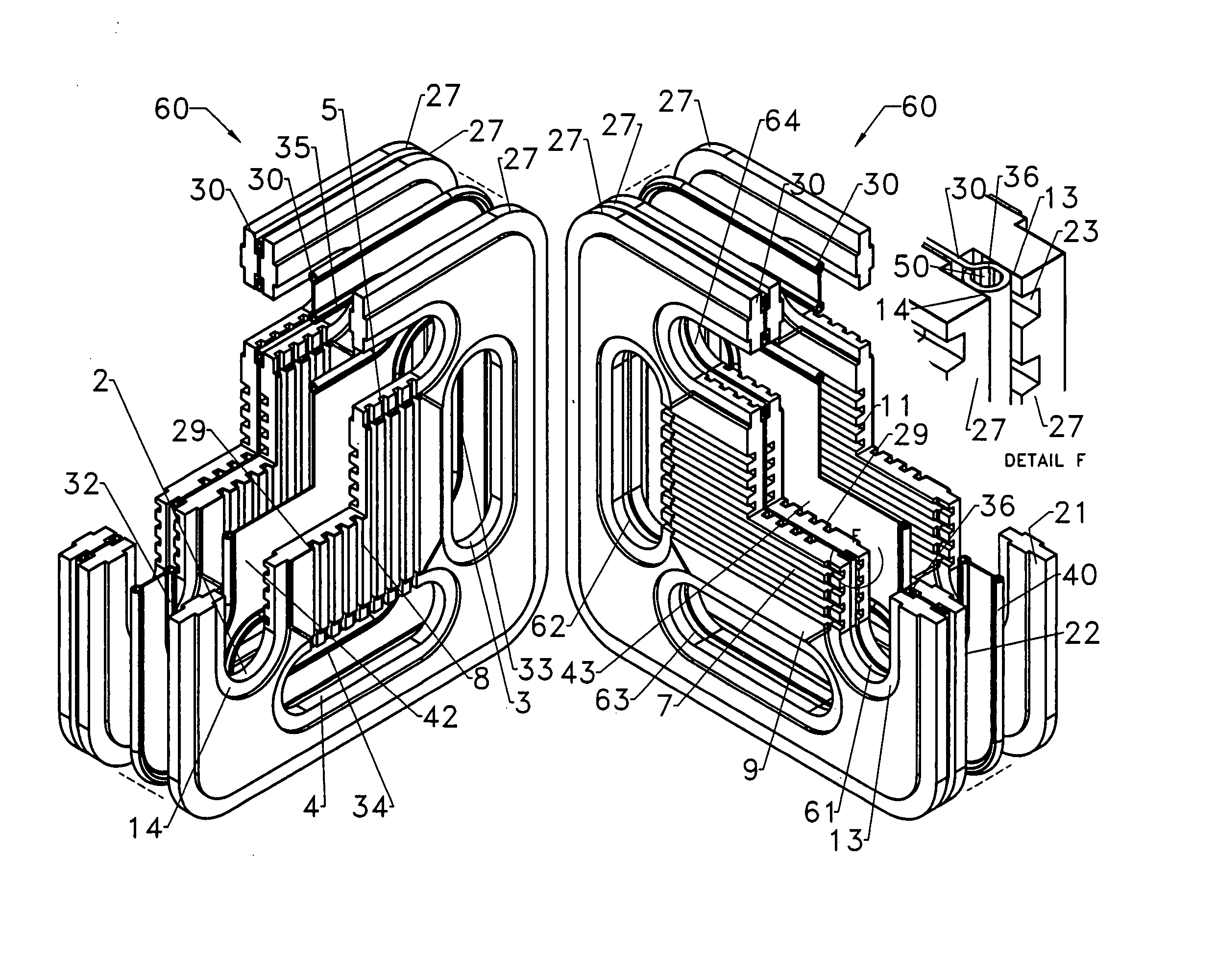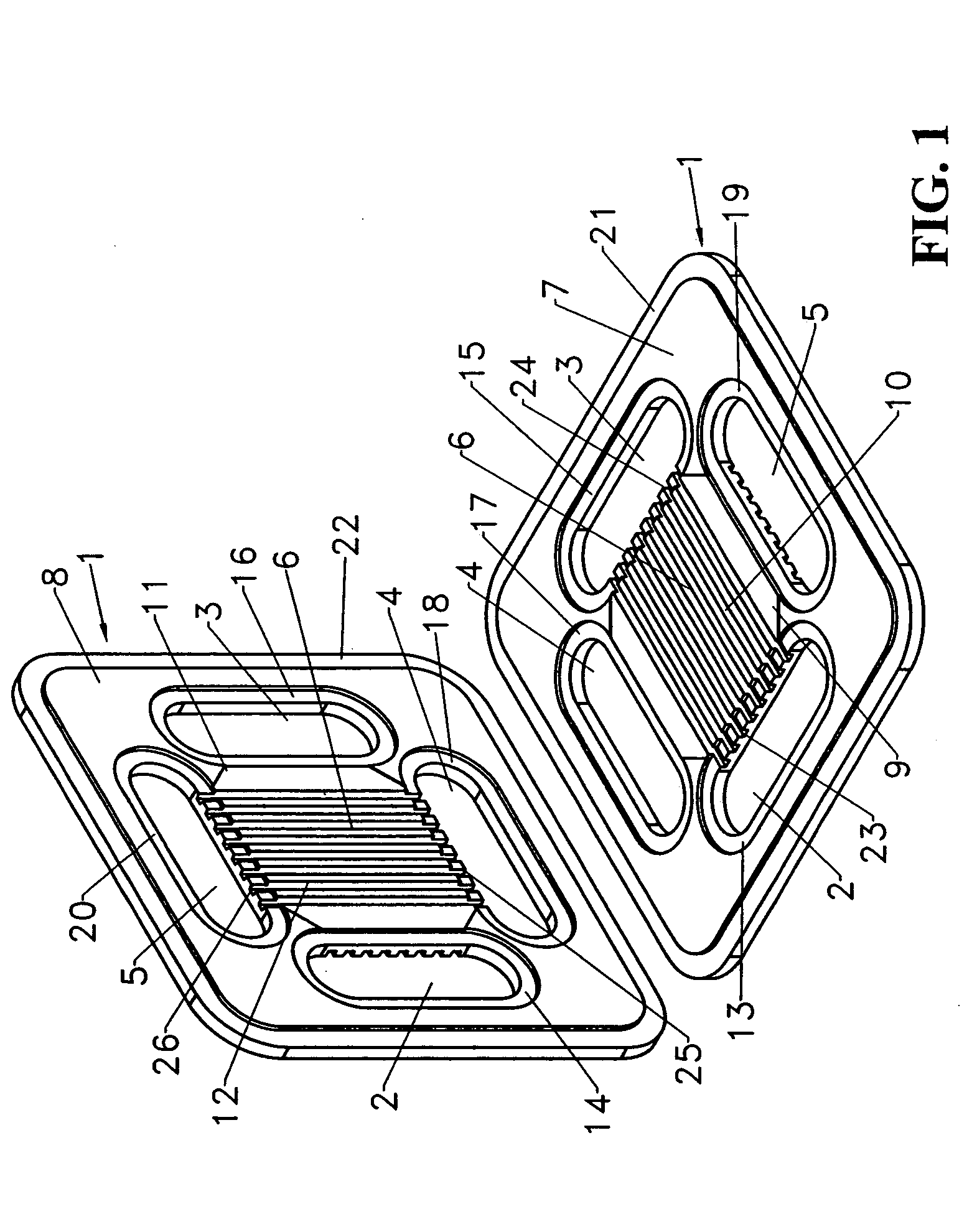[0011] The present invention is directed to high temperature fuel cell stacks including electrochemical cells, bipolar separators, manifolds, and seals capable of being combined together in an integrated
system with
improved performance, durability, and cost, as compared to the prior art.
[0012] According to the present invention, a thin, generally planar metallic bipolar separator is manufactured with integral edge seals and internal manifold seals formed by
curling the
metal edges to produce a tubular bead.
Curling is a conventional, low-cost
metal stamping process widely used to produce smooth finished edges on food tins and similar thin-walled
metal containers. The curled edges of the internal manifold seals have several functions. First, the curled edges form a compliant
gasket seal when clamped between two adjacent electrochemical cells. Second, the curled edges have a beam stiffness to bridge flow grooves in one
electrochemical cell while maintaining sealing pressure on an adjacent cell. Further, the curl direction may be selected such that the
cut metal edges are exposed to only one of the fuel and oxidant gases, thereby facilitating use of layered or coated material. One application of curled edge seals is a bipolar separator with a substrate stable only in fuel gas and an oxidant-resistant
coating on one side. In this example, the preferred curl direction exposes the
cut metal edges to fuel gas.
[0013]
Anode-supported electrochemical fuel cells according to the present invention can incorporate thin metallic bipolar separators with integral edge seals and internal manifold seals. The structural base of the electrochemical fuel cells is a die-formed plate, or structural core, made of porous anode
cermet that includes internal manifold apertures disposed around a central active area. A fuel-contacting side of the core includes molded fuel gas flow grooves that extend from a first internal manifold aperture to a second internal manifold aperture such that the grooves are distributed over the central active area. The oxidant-contacting side of the core has molded oxidant gas flow grooves that extend from a third internal manifold aperture to a fourth internal manifold aperture such that the grooves are distributed over the central active area. A shallow recessed seal surface that accommodates the curled edges of the bipolar separator surrounds each manifold aperture. A similar shallow recessed seal surface can be formed near the outer cell perimeter. A thin, dense YSZ
electrolyte film is applied to substantially the entire structural base, except the central active area on the fuel contacting side where anode material is exposed. A porous LSM cathode layer can then be applied over the YSZ
electrolyte film of the central active area on the oxidant-contacting side. The cathode layer and the underlying electrolyte film follow the contours of the oxidant flow grooves, increasing the
effective power generation area to about 1.5 to 2 times the central active area.
[0014] The electrochemical cells preferably are stacked with metallic bipolar separators between each pair of cells. Dimensions of the bipolar separators can be set to achieve good electrical contact and sealing with an applied axial stack clamping load. The planar areas of the bipolar separators are clamped in direct compression between the central active areas of adjacent cells, providing electrical contact and establishing the cell spacing. The curled edges of the bipolar separators that contact the shallow recessed seal surfaces are flattened to form a compliant seal and accommodate axial dimensional variations. The shallow recessed seal surfaces are wider than the curled edges to accommodate planar dimensional variations and
thermal expansion motions. All cell surfaces contacted by the curled edge seals preferably are coated by YSZ electrolyte film. Since YSZ is an electronic insulator, the metallic bipolar plate does not
electrically short circuit the cells. The YSZ electrolyte
film coating also shields the cell surfaces within the manifold apertures and at the cell perimeter, and prevents unwanted gas
diffusion and reactions.
[0016] The invention may be implemented in various forms. The invention is adapted to internal manifold layouts and gas flow groove configurations in which the fuel and oxidant gases are in cross-flow, parallel-flow, or mixed-flow. The invention also can be adapted to stacks that utilize multiple fuel-in, fuel-out, oxidant-in, and oxidant-out internal manifolds, as well as multistage stacks with
gas transfer manifolds connecting a first group of cells to a second group of cells. The bipolar separator may be formed from a variety of materials and material combinations including
pure metals, alloys, cermets, and layered or coated sheets. Ductile coatings may be applied to the sheet stock prior to forming the seals, while brittle coatings may be applied afterwards. The
thin sheet construction allows high-cost materials to be used economically, and the purely compressive loading in the active area permits use of materials that have relatively low-strength at the
operating temperature. The
thin sheet also minimizes the effects of any thermal expansion mismatch between the bipolar separator and the cells, since the metal is ductile, and yields to follow the expansion of the much thicker
ceramic cell. Further, the
compressibility and beam stiffness of the curled edge seals may be adjusted by inserting materials such as metal wires or
refractory powder packing in the bead.
[0017] The present invention can provide at least the following benefits. First, it provides an integrated bipolar separator and seal component that may be formed using conventional, economical
metalworking techniques from a variety of
metallic materials. Second, it provides cathode or anode supported SOFC cells that form simple and robust fuel cell stacks in combination with the combined bipolar separator and seal component.
 Login to View More
Login to View More 


